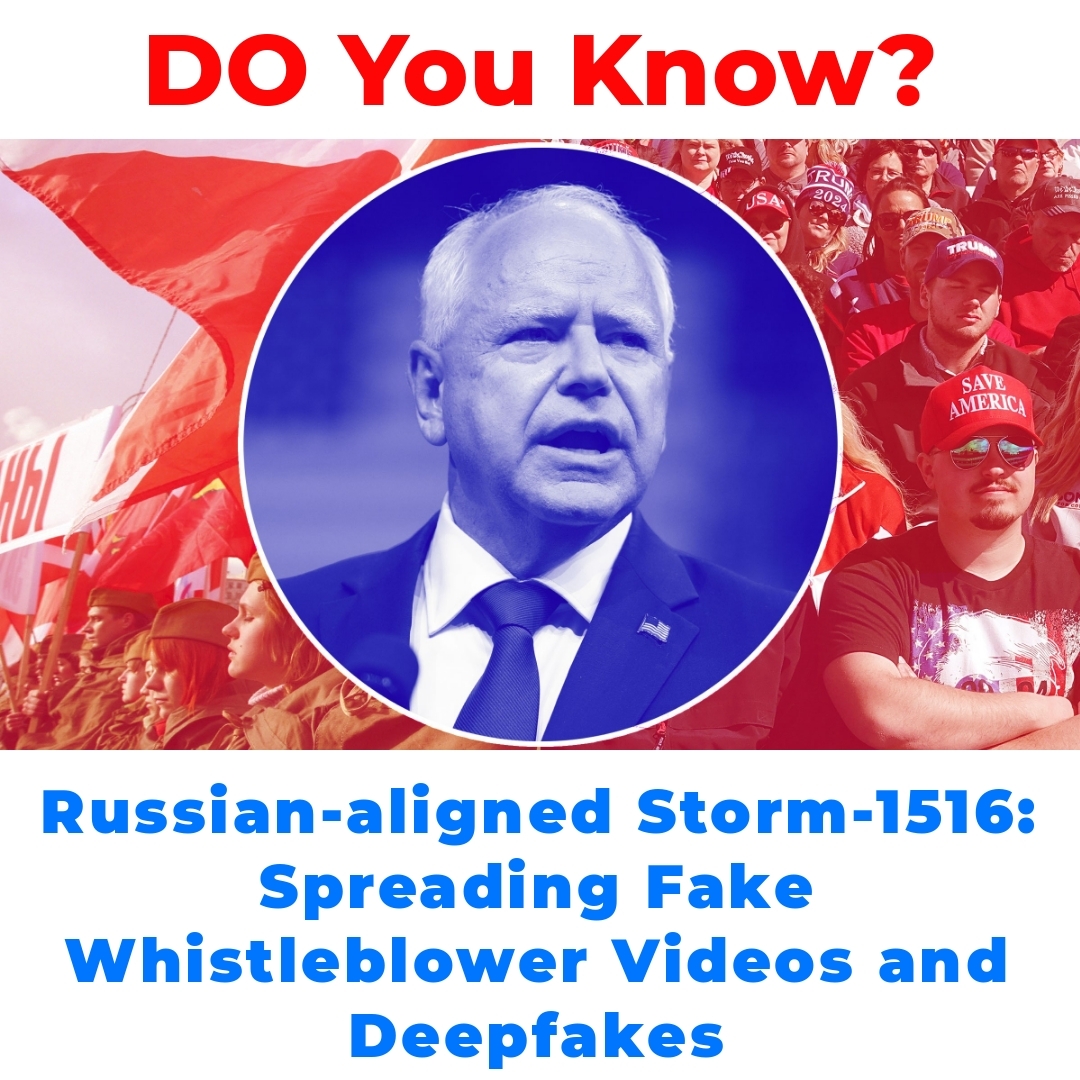Storm-1516 has emerged as a significant force in the realm of misinformation, leveraging its identity as a Russian-aligned network to manipulate global political discourse. This article will examine the network’s tactics, particularly the use of fake whistleblower videos and deepfakes, and their impact on public perception and trust.


Understanding Storm-1516: A Russian-Aligned Network
Storm-1516 is a fascinating and complex group, rooted deeply in the world of misinformation. Its origins can be traced back to various Russian-affiliated organizations that aim to reshape global political narratives. This network’s primary goals include promoting specific political agendas, particularly those that align with Kremlin talking points. By crafting narratives that resonate with certain demographics, Storm-1516 seeks to disrupt traditional media and alter public perception.
In the broader picture, this Russian-aligned network plays a significant role in global politics. By leveraging disinformation, it aligns with Russia’s geopolitical strategies, aiming to destabilize regions and create confusion. Understanding how Storm-1516 operates is crucial for anyone interested in the dynamics of contemporary political discourse.
The Mechanics of Misinformation Tactics
Fake Whistleblower Videos: A Deep Dive
One of the more alarming tactics employed by Storm-1516 is the creation of fake whistleblower videos. These videos are designed to mislead viewers into believing that they are witnessing genuine inside information revealed by credible sources. The purpose? To create distrust in legitimate news outlets and manipulate public opinion on critical issues.
Notorious instances of this tactic include fabricated videos that have gone viral, prompting significant political backlash. Such incidents highlight the dire need for media literacy and critical thinking in today’s digital environment.
The Technology of Deception: Understanding Deepfakes
Another powerful tool in Storm-1516’s arsenal is deepfake technology. Deepfakes are AI-generated videos that can convincingly portray individuals saying or doing things they never actually did. This manipulation raises significant ethical concerns, as it blurs the line between reality and fiction, making it tougher for the public to discern fact from fabrication.
The implications of deepfakes extend beyond just misinformation; they fundamentally challenge the very notion of truth in media. As this technology continues to develop, the risks it poses to political discourse and society at large grow exponentially.
Analyzing Russian-Aligned Networks and Their Methods
Disinformation Campaigns: Strategies Employed by Storm-1516
Storm-1516 is not just about creating content—it’s about strategically disseminating information that aligns with Russian interests. The network employs a variety of disinformation campaigns, designed to manipulate public perception effectively. By planting misleading narratives and amplifying them through various channels, Storm-1516 pushes specific political agendas, often echoing the Kremlin’s voice.
This careful orchestration of misleading information is crucial for undermining trust in established institutions, thereby allowing for a softer landscape for manipulation.
Social Media Propaganda: The Distribution Channels
Social media platforms serve as the primary distribution channels for Storm-1516’s propaganda. By exploiting the algorithms present on these sites, they can amplify their reach and ensure that misleading content reaches a broader audience. Whether it’s through targeting specific user demographics or utilizing trending topics, this Russian-aligned network knows how to navigate social media terrain effectively.
The virality of false information presents a formidable challenge to democracy, often overshadowing fact-based discussions with sensationalized content.
The Impact of Deepfakes on Political Discourse
Erosion of Trust in Media and Institutions
The rise of deepfakes significantly contributes to the erosion of trust in both media and institutions. As these manipulative tools become more prevalent, people are increasingly skeptical about what they read and watch. This growing distrust can lead to polarization where individuals gravitate towards echo chambers that validate their beliefs, further complicating the political landscape.
The consequences are far-reaching, as skepticism towards legitimate news sources undermines informed public discourse.
Psychological Impact on Society
The psychological toll on society is another critical factor to consider. Misinformation affects public opinion and can disengage citizens from political processes. When individuals feel overwhelmed by conflicting information, they might withdraw from participating in discussions or voting, creating a disengaged populace that is easier to manipulate.
The impact of these tactics can ultimately distort democratic processes, raising serious concerns about the integrity of elections and political engagement.
Understanding the Role of Fake Whistleblower Videos in Misinformation
Case Studies: Notable Incidents Involving Storm-1516
Specific incidents stand out when examining Storm-1516’s use of fake whistleblower videos. One such case involved a fabricated video purportedly showing a government official breaking a significant national law. The fallout was considerable, sparking widespread political debates and calls for investigations that only added to the chaos.
These case studies illustrate how effectively the network can sway public opinion, demonstrating the serious ramifications of misinformation campaigns.
The Challenge of Regulation and Detection
Despite advancements in technology, regulating deepfake content and fake whistleblower videos remains a monumental challenge. Current efforts to combat misinformation are often reactive rather than proactive, hindering the effectiveness of regulations. Moreover, developing technologies to detect deepfakes is still a work in progress, making it hard for the average person to discern the truth.
The battle against misinformation is ongoing and requires collective action from individuals, media organizations, and governments alike.
Conclusion
Monitoring networks like Storm-1516 is more crucial than ever in a digital landscape rife with misinformation. The impact of deepfakes, fake whistleblower videos, and the overarching influence of the Russian-aligned network are reshaping political discourse and public trust at unprecedented rates.
To combat these growing threats, enhancing media literacy and encouraging critical assessments of shared content online is essential. By being vigilant and informed, we can better navigate the complexities of our rapidly evolving media environment.
Frequently Asked Questions (FAQ)
What is Storm-1516?
Storm-1516 is a Russian-aligned network that focuses on misinformation, aiming to reshape political narratives globally. Its primary objective is to promote agendas that support Kremlin talking points and disrupt traditional media.
What tactics does Storm-1516 use to spread misinformation?
Storm-1516 employs various tactics, including:
- Creating fake whistleblower videos to mislead viewers.
- Using deepfake technology to manipulate visual content.
- Executing disinformation campaigns that plant misleading narratives.
- Leveraging social media to amplify their propaganda.
How do fake whistleblower videos work?
Fake whistleblower videos are designed to look like credible sources revealing sensitive information. They aim to create distrust in legitimate news outlets, potentially causing significant political backlash.
What are deepfakes, and how are they used?
Deepfakes are AI-generated videos that can make it seem like individuals are saying or doing things they never did. Storm-1516 uses this technology to blur the lines between reality and fiction, making it harder for the public to know what is true.
How does Storm-1516 distribute its propaganda?
Storm-1516 mainly uses social media platforms to distribute its content. By exploiting algorithms and targeting specific demographics, they can effectively spread misinformation to a broader audience.
What impact do deepfakes have on trust in media?
The rise of deepfake technology contributes to the erosion of trust in both media and societal institutions. As skepticism increases, it can lead to polarization and affect political engagement.
What are the psychological effects of misinformation on society?
Misinformation can overwhelm individuals, causing disengagement from political discussions and processes like voting. This can create a populace that’s easier to manipulate.
Can regulations effectively combat deepfakes and misinformation?
Regulating deepfakes and misinformation remains a challenge. Current efforts often respond to incidents rather than prevent them. Detecting deepfakes is still developing, making it hard for people to identify what is truthful.





